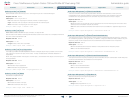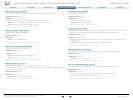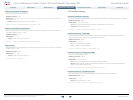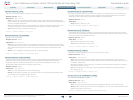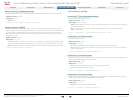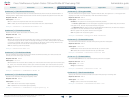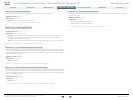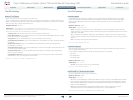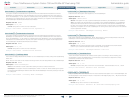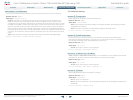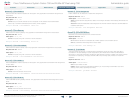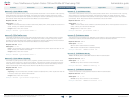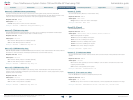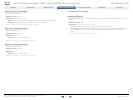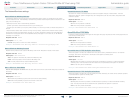
42
Cisco TelePresence System Codec C90 and Prole 65” Dual using C90 Administrator guide
D14635.05 Prole C90 and Codec C90 Administrator Guide TC4.1, February 2011.
Copyright © 2010-2011 Cisco Systems, Inc. All rights reserved.
www.cisco.com
The GPIO settings
GPIO Pin [1..4] Mode
NOTE: This command is not supported on Codec C40.
The four GPIO pins are congured individually. The state can be retrieved by "xStatus GPIO Pin [1..4]
State". The default pin state is High (+12V). When activated as output, they are set to 0V. To activate
them as input, they must be pulled down to 0V.
Requires user role: ADMIN
Value space: <InputNoAction/OutputManualState/OutputInCall/
OutputMicrophonesMuted/OutputPresentationOn/OutputAllCallsEncrypted/
OutputStandbyActive/InputMuteMicrophones>
InputNoAction: The pin state can be set, but no operation is performed.
OutputManualState: The pin state can be set by "xCommand GPIO ManualState Set PinX: <High/
Low>" (to +12V or 0V, respectively).
OutputInCall: The pin is activated when in call, deactivated when not in call.
OutputMicrophonesMuted: The pin is activated when microphones are muted, deactivated when
not muted.
OutputPresentationOn: The pin is activated when presentation is active, deactivated when
presentation is not active.
OutputAllCallsEncrypted: The pin is activated when all calls are encrypted, deactivated when one
or more calls are not encrypted.
OutputStandbyActive: The pin is activated when the system is in standby mode, deactivated
when no longer in standby.
InputMuteMicrophones: When the pin is activated (0V), the microphones will be muted. When
deactivated (+ 12V), the microphones are unmuted.
Example: GPIO Pin 1 Mode: InputNoAction
The H323 settings
H323 NAT Mode
The rewall traversal technology creates a secure path through the rewall barrier, and enables
proper exchange of audio/video data when connected to an external video conferencing system
(when the IP trac goes through a NAT router). NOTE: NAT does not work in conjunction with
gatekeepers.
Requires user role: ADMIN
Value space: <Auto/On/Off>
Auto: The system will determine if the "NAT Address" or the real IP-address should be used
within signalling. This is done to make it possible to place calls to endpoints on the LAN as well as
endpoints on the WAN.
On: The system will signal the congured "NAT Address" in place of its own IP-address within
Q.931 and H.245. The NAT Server Address will be shown in the startup-menu as: "My IP Address:
10.0.2.1".
O: The system will signal the real IP Address.
Example: H323 NAT Mode: Off
H323 NAT Address
Enter the external/global IP-address to the router with NAT support. Packets sent to the router will
then be routed to the system.
In the router, the following ports must be routed to the system's IP-address:
* Port 1720
* Port 5555-5574
* Port 2326-2485
Requires user role: ADMIN
Value space: <S: 0, 64>
Format: String with a maximum of 64 characters.
Example: H323 NAT Address: ""
H323 Prole [1..1] Authentication Mode
Set the authenticatin mode for the H.323 prole.
Requires user role: ADMIN
Value space: <On/Off>
On: If the H.323 Gatekeeper Authentication Mode is set to On and a H.323 Gatekeeper indicates
that it requires authentication, the system will try to authenticate itself to the gatekeeper. NOTE:
Requires the Authentication LoginName and Authentication Password to be dened on both the
codec and the Gatekeeper.
O: If the H.323 Gatekeeper Authentication Mode is set to O the system will not try to
authenticate itself to a H.323 Gatekeeper, but will still try a normal registration.
Example: H323 Prole 1 Authentication Mode: Off
Contents
Contact us
Introduction
Advanced conguration
Password protection
Web interface
Appendices
Advanced conguration



